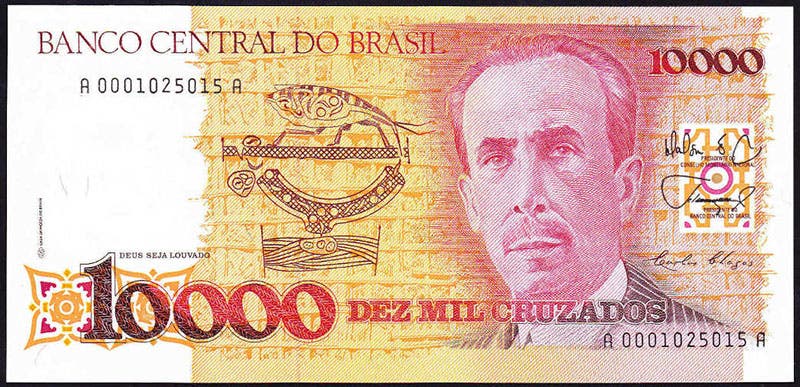Scientist of the Day - Carlos Chagas
Carlos Chagas, a Brazilian clinical physician and microbiologist, died Nov. 8, 1934, at the age of 55. He attended medical school in Rio de Janeiro, and chose malaria as his research topic, the vector for which (the Anopheles mosquito) had just been discovered. He was guided in his work by Oswaldo Cruz, one of the up-and-coming Brazilian experts on infectious diseases, of which Brazil has more than its share. Cruz soon took charge of the local infectious disease institute, which was renamed the Oswaldo Cruz Institute. Chagas spent four years in the field, developing methods of keeping the Anopheles mosquito at bay via insecticides, with a great deal of success. In 1906, he joined the Oswaldo Cruz Institute, and he turned his attention to other microorganisms and their insect vectors.
Sometime before 1909, probably in 1907, Chagas discovered a new microorganism, a trypanosome, which is a microscopic parasitic one-celled organism with a single cilia. He found it in the gut of an insect common in Brazil called a vinchuca or “kissing bug”, with the scientific name of Triatoma infestans. Chagas named the parasite Trypanosoma cruzi, after his mentor, whom he greatly admired (second image). At some later time, but still before 1909, he was treating a baby girl with swollen lymph nodes and organ disfunction, and he found in her blood the very trypanosome he had seen in the kissing bug. Further tests showed that when primates (monkeys) were bitten by the vinchuca bug, they developed similar symptoms to those of his patient. In 1909, Chagas announced the existence of a previously unidentified disease and described the symptoms, both short-term and long-term. More than that, he identified the infectious agent, the vector, and the process of infection (the bug defecates tiny fecal pellets on the skin near the punctures, which the victim rakes into the wound when he or she scratches the bite). That was the first time that an entire infectious disease cycle had been worked out by one person. Admiring physicians immediately took to calling the disease "Chagas disease," and it still has that name.
This was a Nobel-Prize-worthy discovery (although Chagas did not in fact receive a Nobel Prize, a story that has not yet been sorted out). But Chagas disease has a certain fame for another reason. In 1834, Charles Darwin visited Chile in HMS Beagle, and he made several overland trips, including one across the Andes to Argentina. He described in his diary one encounter with “Benchuca bugs,” as he called them, soft, flying insects that crawled over his body and painlessly sucked blood. So there is no doubt that Darwin encountered the host that carries Chagas disease. About 7 years after his return (in 1842), he began to suffer symptoms of heart palpitations, anemia, muscular weakness, intestinal distress, vomiting, and, ultimately, severe flatulence. His illness played a major role in determining the course of the rest of his life, as he moved out of London to Downe, lived in general personal isolation from his contemporaries, and found himself limited in the amount of time he could work, no more than a few hours a day. Did Darwin's life change direction because he suffered from Chagas disease?
Some have thought so, mostly infectious-disease physicians. The first major book on Darwin's illness was written before anyone proposed Chagas disease as a possible culprit, and the author attributed most of Darwin's physical complaints to psychosomatic causes – he was thought to be subconsciously worried about what would happen when he foisted evolution by natural selection on the world. When someone finally connected Darwin's Benchuca bug to Trypanosoma cruzi and Chagas disease, it was quite exciting for a while, especially for those wary of attributing disease to psychosomatic causes. But then it was pointed out that many of Darwin's symptoms, such as the recurrent vomiting and flatulence, were not typical of those suffering from Chagas disease, and the disease gradually faded into the background in discussions of Darwin's illness.
Recently, there has been an upsurge of interest in Chagas disease as a principal cause of Darwin's physical problems. One medical researcher plotted Darwin's activities in South America and calculated that Darwin spent 128 days, sleeping outdoors or in local houses, in an area where Chagas disease is "hyperendemic," concluding that there is no way Darwin could have escaped being infected with Trypanosoma cruzi numerous times. Others have pointed out that the long-term effects of the disease can include stomach and bowel lesions, which could have caused some or all of Darwin's intestinal problems.
So the jury is still out on Charles Darwin and Chagas disease. But there is no doubt that Carlos Chagas pulled off one of the infectious-disease coups of all time when he provided the complete blueprint for a new tropical disease, all by himself. It is, of course, mere coincidence that he did so in 1909, the centennial year of Darwin’s birth.
In 1925, Chagas was photographed with a visiting Albert Einstein (third image). Einstein had won the Nobel Prize in Physics in 1921. Chagas was nominated for the prize in Medicine/Physiology in 1921, but did not win.
IN 1988, Brazil issued a banknote honoring Carlos Chagas (fourth image). It was a 10,000 cruzado note, so probably not many people saw one, and that may be just as well. In addition to the portrait of Chagas, there is, at top left-center, a depiction of a kissing bug, sucking blood. Its other end has deposited a fecal pellet on the skin, inside of which a tiny trypanosome is barely visible, about to be raked into a bite hole and bringing infection with it. This may be the only time fecal contamination has been depicted on a species of world currency.
William B. Ashworth, Jr., Consultant for the History of Science, Linda Hall Library and Associate Professor emeritus, Department of History, University of Missouri-Kansas City. Comments or corrections are welcome; please direct to ashworthw@umkc.edu.










